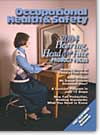
March 2004
Cover Story
By Maurice H. Miller, Ph.D.
THE final rule on recording hearing loss (HL) was published in the Federal Register on July 1, 2002. It is a revision of 29 CFR 1904, Occupational Injury and Illness Recording and Reporting Requirements, as they pertain to recording HL. Details are reported in the Federal Register (Vol. 67, #126, pp. 44037-44038). Major provisions are the following:
Features
By Roger Brooks, Jr.
DEVELOPING standards to protect workers' well-being is a great way to get started on the path toward a healthy and injury-free workplace. But as any safety expert will tell you, it takes dedication, perseverance, and a desire to make sure every employee is as safe as can be while on the job.
By Dan Webster
IN the world of occupational heat stress, including professional sports such as American football, employers and employees must find some accommodation between reasonable productivity and reasonable heat stress illness prevention.
By Berta Lippert
ARE you in charge of creating a lockout/tagout (LOTO) program for your company? If so, beyond being familiar with the standard, you must fully understand the process of creating and implementing a successful LOTO program that will ultimately save time, injuries, and possibly lives.
By James K. Byrnes
WEARERS of hard hats will look and feel better as helmet manufacturers continue to develop products that improve comfort and ease of use.
By Jerry Laws
THE revised ANSI Z359.1 standard coming out this year is not meant to be the last word on fall protection programs and equipment, because the Z359 committee already plans to append at least three sections to it.
By Mark H. Stromme
WORKERS depend on their five senses--sight, hearing, smell, taste, and touch--to keep them alert to their surroundings and to any danger present. It's important to note that four of the five sense organs are housed in the head. The brain (the organizer of all that data collected by the senses) is also located there.
By Douglas B. Walters, Ph.D., CSP, Ray F. Ryan
THE attack on the World Trade Center and the anthrax scare have forced the government and private industry to increase safety and security precautions. The anthrax scare, in particular, has prompted greater safety controls in the mailroom.
By Michael R. Roop
THE updated standard for fall protection, ANSI Z359, will contain two important guidelines for rescue. A portion designated Z359.0 will provide facility managers a plan to build and maintain rescue operations, while Z359.3 is a new standard dedicated to the construction, use, and training required for fall protection rescue equipment.
By Michael C. Wright, PE, CSP, CPE, Moniqua Suits
IT is a beautiful sunny day in the Midwest, and a construction crew is setting the decking on bridge girders located over an interstate highway. Their horizontal lifeline (HLL) system is attached to each girder with a steel cable height of approximately 42 inches (waist height) and 2-inch squared steel posts supporting the steel cable system.
Departments
By Barbara Hemphill
SPENDING more time at home and with loved ones has become increasingly important. With all the crazy events that have made the news, why would anyone want to leave home? Technology has made it so telecommuting is once again "in style," and employers who are looking to cut costs and increase productivity are seeing its benefits, as well.
By Valerie Weadock
AS a bookkeeper responsible for large amounts of data entry, Sue Schwarz spent extended hours sitting in front of a computer screen, her hands busily typing away at the keyboard. After a few years on the job, Schwarz began feeling tenderness in her wrists, a tingling sensation in her lower arm, and numbness in her fingers.
By Jerry Laws
THIS must be an election year. First The New York Times piled on John L. Henshaw's OSHA. Now, the punch comes from another direction. It's a sharp jab, not a long, looping right that's easy to dodge.